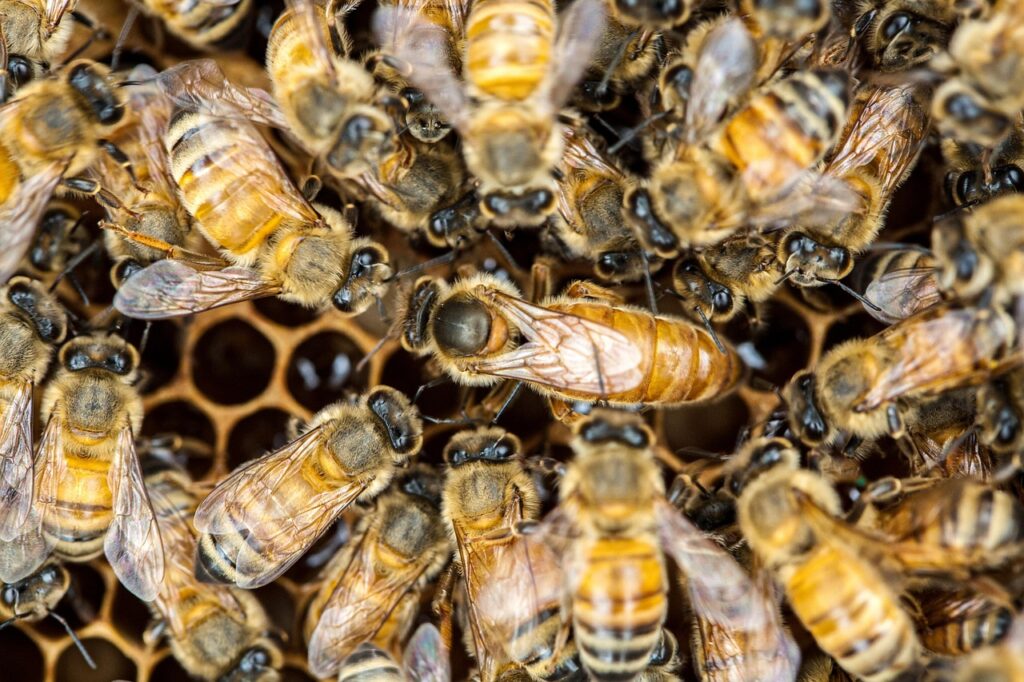Bees communicate within a hive using a combination of movement (dances), chemical signals (pheromones), vibrations, touch, and sound.
Each method serves specific purposes and conveys distinct types of information to keep the colony organized and functioning efficiently.
1. Dances
- Waggle Dance: Forager bees use the waggle dance to tell others about the direction, distance, and quality of a nectar or pollen source. The bee moves in a figure-eight pattern; the angle of the waggle run relative to gravity indicates the direction of the food source in relation to the sun, while the length and vigor of the waggle signal how far and profitable the site is. The bee also brings back the scent of the flower to help others identify the source[1][2][3].
- Shake Dance: This dance recruits more foragers to go out when nectar sources are abundant. The bee shakes her abdomen in front of non-foraging workers, triggering them to go to the dance floor and watch the waggle dance for specifics[1][4].
- Tremble Dance: When returning foragers bring back so much nectar that it overwhelms nectar processors, this dance signals the need for more workers to process nectar into honey. The dancer quivers and moves slowly through the hive, stimulating more bees to help process the influx[1][2].
2. Pheromones (Chemical Communication)
- Bees use a variety of pheromones for different messages:
- Alarm pheromones: Released in response to threats, alerting and mobilizing other bees for defense[3][5].
3. Vibrations and Sound
- Vibration signals: Some bees communicate by rapidly vibrating their bodies or producing specific buzzing frequencies. These signals can motivate other bees to increased activity, warn about danger, or signal specific needs within the hive[4][5].
- Sound cues, such as distinct buzzes or humming, can indicate colony states—like swarming, queen presence, or stress—and play a role in coordinating group behavior and readiness[5].
4. Touch
- Bees use their antennae to touch and taste each other, particularly during dances, to interpret signals and verify information. Measuring the size of comb cells with their feet is another tactile communication method that supports building and hive management[7].
Summary Table: Bee Communication Methods
| Method | How it Works | Purpose |
| Waggle Dance | Figure-eight movement, waggle phase | Location, distance, quality of food |
| Shake Dance | Shaking abdomen in front of workers | Recruit more foragers |
| Tremble Dance | Quivering body, slow movement | Enlist more nectar processors |
| Pheromones | Chemical secretion | Alarm, queen status, reproduction |
| Vibrations | Body shaking, buzzing | Activity boost, warnings, coordination |
| Touch | Antennae and feet contact | Verifying signals, comb measurement |
Bees’ sophisticated communication system ensures efficient teamwork, quick response to environmental changes, and the survival of the colony as a cooperative unit[1][7][2].
⁂
- https://www.pbs.org/wgbh/nova/bees/hivecomm.html
- https://beeswiki.com/how-do-bees-communicate/
- https://www.mannlakeltd.com/blog/how-do-honey-bees-communicate/
- https://beeculture.com/communication-among-bees/
- https://www.apicolturalaterza.it/gb/blog/the-language-of-bees-this-is-how-bees-communicate-b74.html
- https://canr.udel.edu/maarec/honey-bee-biology/the-colony-and-its-organization/
- https://www.mannlakeltd.com/blog/how-do-bees-communicate/



